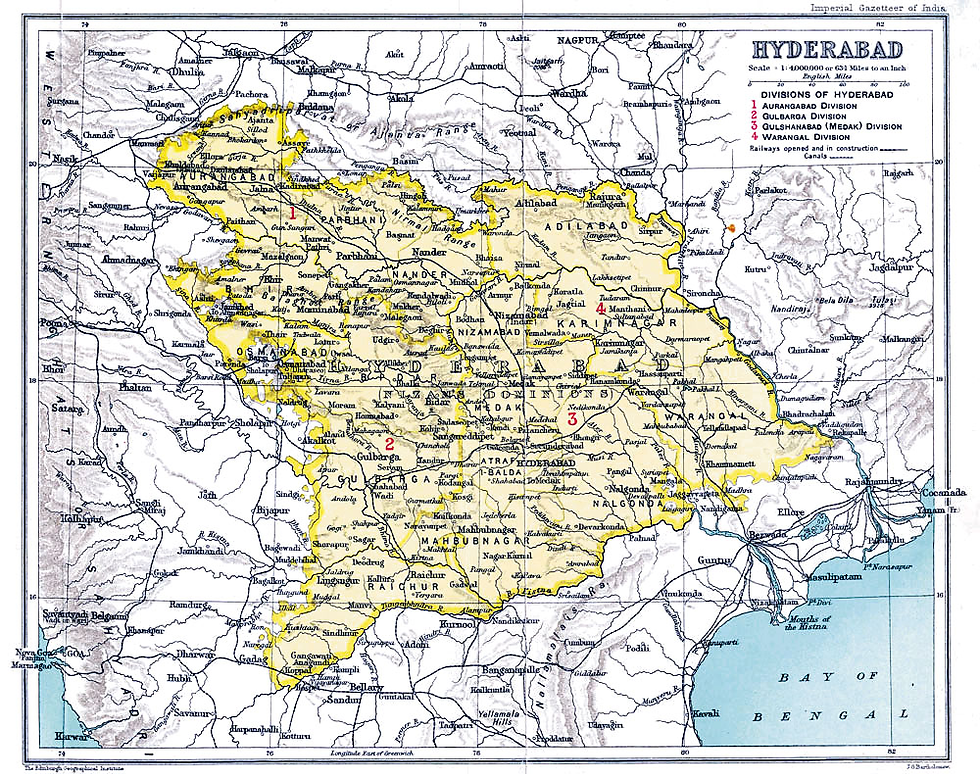24 | Gwalior, Indore and Malwa States
- indiastatestories
- Aug 20
- 4 min read
The Malwa region in central India had two big states – Gwalior and Indore. Besides Gwalior and Indore, other important states included Dhar and Dewas (Senior and Junior branches), whose ruling families were Puars (Parmara Rajputs). Other states like Ratlam, Alirajpur, Barwani, Jhabua, Khilchipur, Narsingarh, Sailana, Sitamau, Jobat, Kathiwara, Mathwar, Rajgarh, Nimkhera, Jamnia, Piploda (Rajput states), and Jaora, Kurwai, Muhammadgarh, Pathari (Muslim states) were also part of this region. Together, it covered an area of approximately 47,000 square miles with a population of over 70 lakh people and an annual revenue of about 80 million rupees. Smaller states were scattered and often not contiguous, making it difficult to form viable units for administration. Many lacked the resources for modern administration and welfare services (White Paper, 1950).

The Gwalior State was founded by Ranuji Maharaj, who rose in the Peshwa's service. The Scindias reached their peak under Madhoji Scindia, who became the virtual ruler of northern India by controlling the titular Mughal Emperor, Shah Alam II. However, the reign of his grand-nephew, Daulat Rao Scindia, brought disasters, leading to a subsidiary alliance treaty with the British in November 1817. The Holkar family ruled Indore state. Gwalior and Indore were frequently at war, even when nominally at peace (Menon, 1956).


The Maharajas of Gwalior and Indore were initially hesitant to pool their sovereignties, and there was strong sentiment in Gwalior against losing its distinct identity. Some rulers believed that Maratha states were being "singled out for obliteration," unlike Rajput states. The strained relations and traditional hostility between the ruling families of Gwalior and Indore posed a challenge to their smooth cooperation within a single union. Congress organisations in Central India were generally not strong, except in Gwalior and Indore. This meant that popular pressure for responsible government, a driving force in some other mergers, was less pronounced initially (Menon, 1956).
Despite these complexities, V.P. Menon, with Sardar Patel's support, advocated for the formation of a single, large union rather than multiple smaller ones. This was seen as the only satisfactory solution for ensuring administrative viability and promoting agricultural development in the fertile Malwa region. The entire area of Malwa was linguistically, culturally, and economically homogeneous, primarily Hindi-speaking, which facilitated this consolidation. V.P. Menon engaged in continuous discussions with the rulers, particularly the Maharajas of Gwalior and Indore. He pointed out that smaller states could not survive independently and that a union would benefit agricultural development. Sardar Patel's overarching view was that, with the exception of Hyderabad and Mysore, all other viable states would eventually be integrated into larger units (Menon, 1956).

Menon also assured the rulers that their Privy Purses and private properties would be guaranteed by the Central Government, offering a more secure future than leaving it to local leaders. This persuasion, along with the logic that joining the union would make the Gwalior Maharajah the constitutional head of the whole of Central India, eventually led to their agreement. States Ministry officials also advised local Congress organisations to work in support of unification rather than agitate for responsible government in individual small states that had no future on their own. The Indian States Finances Enquiry Committee later addressed the integration of federal finance across these unions (Menon, 1956).
The covenant forming the United State of Gwalior, Indore and Malwa (Madhya Bharat) was signed by practically all the rulers on 22 April 1948 and inaugurated on 28 May 1948. The Maharajas of Gwalior and Indore were designated as the Rajpramukh and Up-Rajpramukh, respectively, for life. Unlike earlier unions where an optional provision was included, the Madhya Bharat covenant made it mandatory for the Rajpramukh to execute an Instrument of Accession acceding on all federal and concurrent subjects in the Government of India Act of 1935. Later, the Rajpramukhs also agreed to apply provisions relating to water supplies in their Unions, mirroring the provinces' relationship with the Centre (White Paper, 1950).

While the "Eastern States formula" was generally applied for most rulers, the larger states like Gwalior and Indore received ad hoc, substantially higher privy purses. The Maharajah of Gwalior's privy purse was fixed at Rs 25 lakh, and the Maharajah of Indore at Rs 15 lakh. This was a departure from the Rs 10 lakh ceiling generally applied and was fixed in recognition of their voluntary merger and strategic importance (Menon, 1956).
Madhya Bharat was unique in having a large population of backward Bhil tribes within its borders. The covenant stipulated that areas with more than fifty percent Bhil population would be designated as Scheduled Areas. The authority to make laws for the peace and good government of these areas was conferred on the Rajpramukh, subject to the control of the Government of India. This was intended to protect these vulnerable populations from an inexperienced democratic government (Menon, 1956).
The integration was presented as a cooperative effort, with the offer of Privy Purses and guarantees for private properties acting as a ‘quid pro quo’ for the rulers surrendering their ruling powers.
References:
Menon, V. P. (1956). The Story of Integration of the Indian states. Orient Blackswan.
White Paper on Indian States. (1950). Ministry of States, Government of India. https://en.wikisource.org/wiki/White_Paper_on_Indian_States_(1950)




Comments